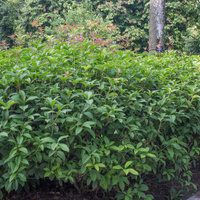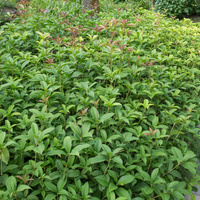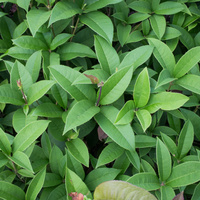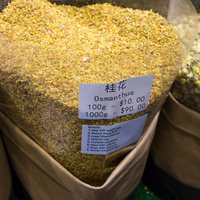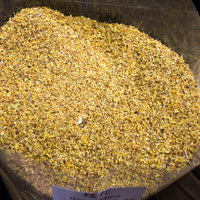Common name: Sweet osmanthus
Other common names: Fragrant olive, Sweet olive, Tea olive
Description
Sweet osmanthus is a shrub to small tree originating in the region extending from the Himalayan foothills to southern China, where it has long been cultivated for its sweetly fragrant flowers, these being used to make high-end perfumes, as well as to flavour teas and cakes.
It may reach heights of up to 12 m (40 ft), though is more commonly 3 to 5 m (10 to 16 ft) tall with a short trunk supporting a densely leafy rounded crown. The bark is light grey and rough.
Leaves are elongated-oval, 5 to 10 cm (2 to 4 in) long, bronze when young, become glossy green when mature and have smooth or finely toothed margins. They are arranged opposite or sub-opposite along the branches and remain on the plant throughout the year.
The flowers are small, four-petaled, fleshy, either creamy-white or less commonly orange and in rounded clusters arising at the leaf base. They are sweetly fragrant, suggestive of ripe apricots and pineapple and either female or male on separate plants. Flowering is at its fullest from autumn to spring, with light, intermittent flowering at other times.
Fertilized flowers are followed by small oval fruit up to 1.5 cm (0.6 in) long. Green when young, they become dark purple to black when ripe, with fleshy pulp surrounding a single seed.
Use
Its low-branching habit lends to it being cultivated as a hedge or privacy screen, but it is more usually left untrimmed as a shrub or small tree to let the sweetly fragrant flowers bloom and perfume the garden.
The flowers yield a sweetly fragrant, jasmine-like essential oil used in high-end perfumes of the oriental type, including 'Cerutti', 'Ciao', 'Eau d'Issey', 'Mille', 'Nino and 'Red'. A delicate oil, it must be extracted from the flowers using a solvent, usually petroleum ether. This results in a fragrant wax-like substance known as an essence concrete, which is then washed with alcohol and concentrated into the essential oil. Solvent extraction is a more technical and expensive process than steam distillation but yields a purer oil, commonly referred to as an absolute. It takes about 3,000 kg (6,600 lbs) of flowers to produce 1 kg (2.2 lbs) of absolute.
An extract of the flower is used to scent and flavour teas and cakes in its native China.
The flowers also have insect repellent properties.
Health use
In traditional medicine, the flowers are used to relieve coughs and extracts of the root to treat dysmenorrhea (menstrual cramps) and rheumatism.
Climate
Grows and blooms naturally in humid subtropical and tropical mid- to high-elevation climates, generally areas with annual lows of 8 to 18°C, annual highs of 19 to 32°C, annual rainfall of 800 to 4500 mm and a dry season of 7 months or less.
Although Sweet osmanthus also grows well in tropical climates, as a small tree, shrub or hedge, the plant usually fails to bloom because chilling temperatures are needed to trigger flowering. Generally, Sweet osmanthus may fail to flower or do so poorly in areas where the average low of the coldest month is above 12°C (54°F).
Growing
New plants are usually started from cuttings of semi-mature wood. Performs best on well-manured, free-draining clay-loam, loam and sandy-loam soils of a moderately acid to neutral nature, generally with a pH of 5.0 to 7.5 and on sites with partial sun to light shade exposure.
Problem features
Sweet osmanthus is widely introduced and cultivated in non-native areas and is listed as a weed in at least one reference publication. Still, there does not appear to be any record of it anywhere as a serious weed. It is assessed as a low weed risk species for Florida by the IFAS Assessment of Non-Native Plants in Florida's Natural Areas.
Where it grows
References
Books
-
Adams, C. D. 1972, Flowering plants of Jamaica, University of the West Indies, Mona, Greater Kingston
-
Arctander, S. 1960, Perfume and flavor materials of natural origin, Elizabeth, New Jersey
-
Burke, D. 2005, The complete Burke's backyard : the ultimate book of fact sheets, Murdoch Books, New South Wales, Australia
-
Church, G. & Greenfield, P. 2002, Trees and shrubs for fragrance, David Bateman, Auckland, New Zealand
-
Clay, H. et al. 1987, Tropical shrubs, University Press of Hawaii, Honolulu
-
Editors of Sunset Magazine 2012, The New Western Garden Book: The Ultimate Gardening Guide, 9th edition, Sunset Publishing Corporation, California
-
Genders, R. 1978, Scented flora of the world, Robert Hale Publishing, London & St. Martin's Press, New York
-
Gilman, E. F. 1997, Trees for urban and suburban landscapes, Delmar Publishers, Albany, New York
-
Groom, N. 1997, The new perfume handbook, 2nd ed., Blackie Academic & Professional, London
-
Macmillan, H. F., et al. 1991, Tropical planting and gardening, 6th ed., Malayan Nature Society, Kuala Lumpur, Malaysia
-
Perry, B. 2010, Landscape plants for California gardens: an illustrated reference of plants for California landscapes, Land Design Publishing, Claremont, California
-
Randall, R. P. 2002, A global compendium of weeds, R.G. and F.J. Richardson Press, Melbourne
-
Randall, R. P. 2007, The introduced flora of Australia and its weed status, Cooperative Research Centre for Australian Weed Management, Glen Osmond, South Australia
-
Seidemann, J. 2005, World spice plants: economic usage botany taxonomy, Springer-Verlag, Berlin
Articles, Journals, Reports and Working Papers
-
Douglas M. & Heyes J. & Smallfield B. 2005, Herbs, Spices and Essential Oils Post-Harvest Operations in Developing Countries, Food and Agriculture Organization of the United Nations (FAO), Rome
